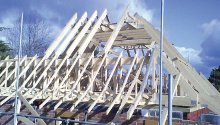Rafter raisers
23 March 2013Improved construction indicators point to more optimistic times for the trussed rafter sector. Stephen Powney reports
A brighter construction future was forecast when trussed rafter fabricators and industry suppliers converged on Redditch recently for the Trussed Rafter Association (TRA) annual general meeting.
TRA chairman Paul Baron reeled off several forward-looking industry forecasts suggesting housebuilding will expand, but was mindful of previous false dawns.
"Last year seemed to promise so much but I think for many of us it delivered even less than 2011," he said.
Mr Baron said government schemes like New Buy, which it is hoped will extend beyond March 2015, had boosted housing by around 3,000 units.
He also singled out other government initiatives such as "build now pay later", public land disposal, reform of planning legislation, First Buy and the Get Britain Building fund as all laudable efforts by the government.
Mr Baron said that in a recent Barratts survey the number of respondents finding it difficult to find a mortgage had halved during the past year.
He said NHBC private starts in 2012 show the top 11-50 builders had a spurt at the end of 2012, although the largest builders were still doing better.
Housing shortage
"The stock market has also called the bottom of the housing slump and has invested in listed builders, recognising that the fundamentals of the industry are sound - that we do not have enough houses."
The Construction Products Association has revised its housing starts forecast for 2013 upwards by 6% to 101,900, with public housing starts predicted to decline by 3%. That makes a total of +4.5% on 2012.
Experian's own forecast has also been revised upwards to +7%.
"I think 2013 will be better than 2012 but not a game-changer for our industry," said Mr Baron. "But if we can see tangible benefits from the measures introduced during 2012 they must manifest themselves as more housing starts."
He said the truss industry had lost 30% of its capacity in the last few years.
"So when I see double digit-growth in housing starts, housebuilders could be waiting a long time for trusses or paying a big premium for their trusses."
However, he added that he didn't think capacity would be a problem when the market picks up. "New companies will start up to service the demand," he said.
Second-hand fabrication machinery bought from companies that had gone bust or wanted to sell old equipment had now worked its way through the system, Mr Baron added, although it was possible some companies or entrepreneurs were storing the technology and waiting for the upturn.
Unsurprisingly, the TRA's membership fell during 2012, with the loss of three fabricators. However, timber company Stora Enso joined and two new fabricators are expected to sign up soon.
Training is under review as there have been too few trainees to justify tutorial support, while a reduction in the number of people attending meetings was also reported.
To meet the challenge of engaging members, the TRA distributed a questionnaire to members asking them what they wanted from the association.
"We have to provide value for money," said Mr Baron, adding that TRA subscription fees this year will be held at the same level as 2012.
TRA publicity plans for 2013 include advertising the new TRA website (see below) to builders and specifiers, conducting a metalweb joists campaign, promoting the benefits of TRA membership and looking at whether the organisation needs an external PR agency to drive publicity.
